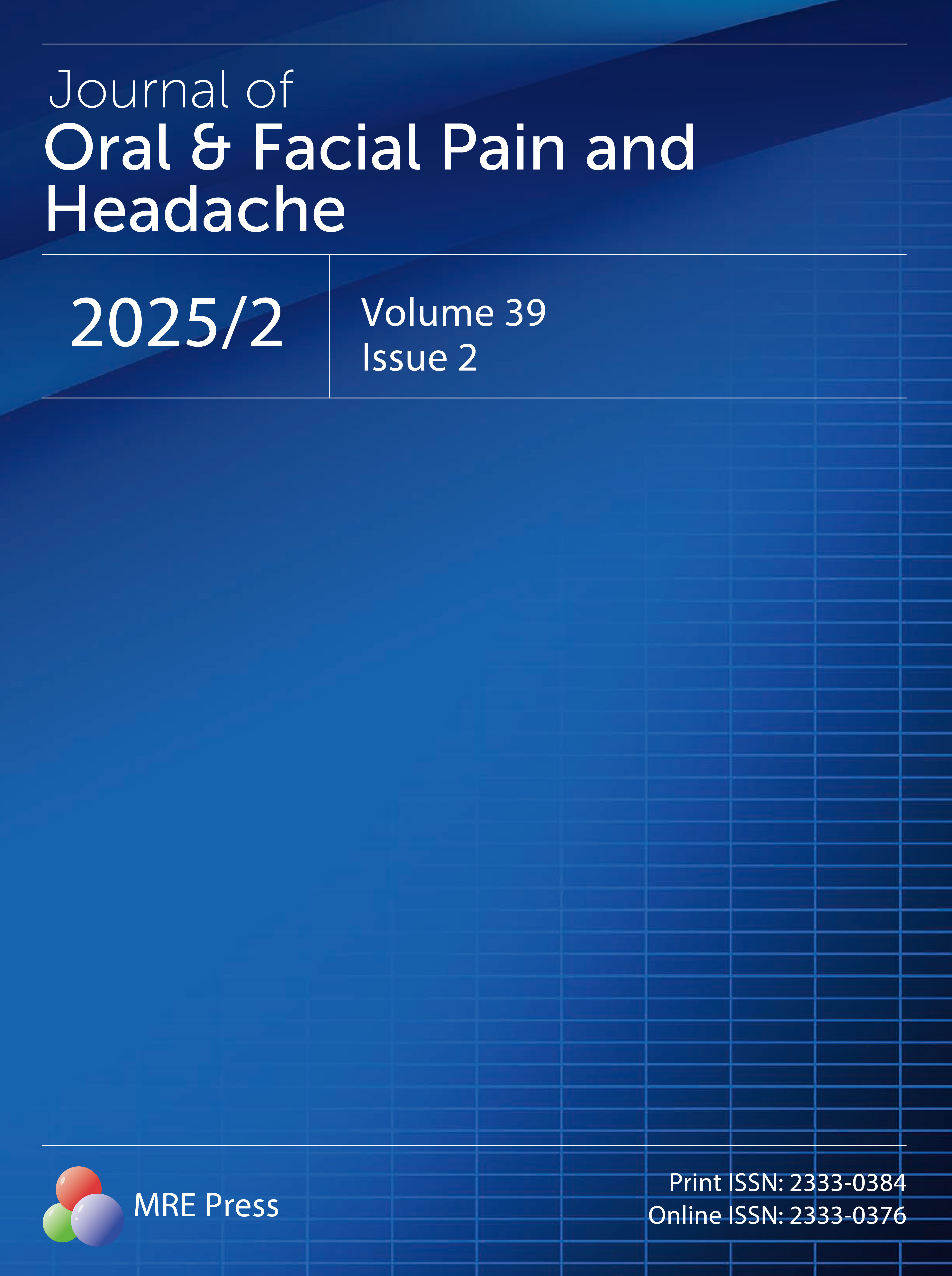Title
Author
DOI
Article Type
Special Issue
Volume
Issue
Article Menu
Export Article
More by Authors Links
Article Data
- Views 885
- Dowloads 40
Journal of Oral & Facial Pain and Headache (OFPH) is published by MRE Press from Volume 38 lssue 1 (2024). Previous articles were published by another publisher on a subscription basis, and they are hosted by MRE Press on www.jofph.com as a courtesy and upon agreement with Journal of Oral & Facial Pain and Headache.
Original Research
Open AccessIntegration of Basic Sciences into the Predoctoral Curriculum to Study Temporomandibular Disorders and Orofacial Pain
Integration of Basic Sciences into the Predoctoral Curriculum to Study Temporomandibular Disorders and Orofacial Pain
1Faculty of Dentistry, University of Toronto, Toronto, Ontario, Canada
*Corresponding Author(s): Barry J. Sessle E-mail: barry.sessle@utoronto.ca
Abstract
This paper outlines several aspects of the integration of basic sciences into the predoctoral dental curriculum. It addresses a number of the points or questions posed by the organizers of the Third Educational Conference to Develop the Curriculum in Temporomandibular Disorders and Orofacial Pain. The importance of the basic sciences for a comprehensive overview of knowledge bearing on temporomandibular disorders and orofacial pain is first emphasized, followed by considerations of what material should be taught and by whom. The paper concludes by considering at what stage of the curriculum this material should be included, how the pertinent basics sciences should be taught, and under what circumstances. Under the term “basic sciences” are included not only relevant biomedical or biologic sciences such as physiology and anatomy, but also the behavioral sciences such as psychology and cognitive science.
Keywords
biological sciences; behavioral sciences; curriculum; dentistry; temporomandibular disorders; orofacial pain; continuing education
Cite and Share
Barry J. Sessle. Integration of Basic Sciences into the Predoctoral Curriculum to Study Temporomandibular Disorders and Orofacial Pain. Journal of Oral & Facial Pain and Headache. 2002. 16(3);181-184.
References
1. Field MJ (ed). Dental Education at the Crossroads: Challenges and Change. Washington, DC: National Academy Press, 1995.
2. Mohl ND. The anecdotal tradition and the need for evidence-based care for temporomandibular disorders. J Orofac Pain 1999;13:227–231.
3. De Bont LGM. Degenerative and inflammatory temporomandibular joint disorders: Basic science perspectives. In: Sessle BJ,Bryant PS, Dionne RA (eds). Progress in Pain Research and Management. Vol 4: Temporomandibular disorders and related pain conditions. Seattle: IASP Press, 1995:133–140.
4. Rugh JD, Dahlstrom L. Behavioral and psychological mechanisms. In: Zarb GA, Carlsson GE, Sessle BJ, Mohl ND (eds). Temporomandibular Joint and Masticatory Muscle Disorders. Copenhagen: Munksgaard, 1994: 208–220.
5. Sessle BJ. The neural basis of temporomandibular joint and masticatory muscle pain. J Orofac Pain 1999;13: 238–245.
6. Stohler CS. Muscle-related temporomandibular disorders. J Orofac Pain 1999;13:273–284.
7. Storey AT. Unresolved issues and controversies. In: Zarb GA, Carlsson GE, Sessle BJ, Mohl ND (eds). Temporomandibular Joint and Masticatory Muscle Disorders. Copenhagen: Munksgaard, 1994:584–615.
8. Lund JP, Lavigne G, Dubner R, Sessle BJ (eds). Orofacial Pain: From Basic Science to Clinical Management. Chicago: Quintessence, 2001.
9. American Association of Dental Schools. Curriculum guidelines for the development of predoctoral programs in temporomandibular disorders and orofacial pain. J Dent Educ 1992;56(9):646–649.
10. Attanasio R, Mohl ND. Educational guidelines for temporomandibular disorders. J Craniomandib Disord Facial Oral Pain 1992;6:123–134.
11. Proposed model of pre-doctoral curriculum on pain for dental schools. IASP Newslett May/June 1993.
12. Attanasio R. The study of temporomandibular disorders and orofacial pain from the perspective of the predoctoral dental curriculum. J Orofac Pain 2002;16:176–180.

Abstracted / indexed in
Science Citation Index (SCI)
Science Citation Index Expanded (SCIE)
BIOSIS Previews
Scopus: CiteScore 3.1 (2024)
Cumulative Index to Nursing and Allied Health Literature (CINAHL)
Submission Turnaround Time
Preliminary Review: Typically 1–7 days (median: 5 days)
Peer Review: Typically 4–16 weeks (median: 8.6 weeks)
Notes: Review times may vary depending on manuscript complexity or reviewer availability, with some articles requiring longer than 16 weeks. Your information is kept confidential throughout the review process.
Top
